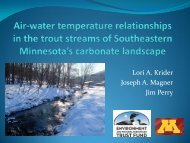Minnesota Water Resources Conference - Water Resources Center ...
Minnesota Water Resources Conference - Water Resources Center ...
Minnesota Water Resources Conference - Water Resources Center ...
You also want an ePaper? Increase the reach of your titles
YUMPU automatically turns print PDFs into web optimized ePapers that Google loves.
Concurrent Sessions III 3:15–4:45<br />
Track D: Sediment Loading<br />
BOOK OF ABSTRACTS<br />
Tuesday, Monday, October 27 23<br />
Sediment loading in the LeSueur River Basin<br />
Stephanie Day, University of <strong>Minnesota</strong>, dayxx196@umn.edu; Patrick Belmont, University of <strong>Minnesota</strong>; Karen Gran, University<br />
of <strong>Minnesota</strong>; Carrie Jennings, <strong>Minnesota</strong> Geological Survey; Andrea Johnson, University of <strong>Minnesota</strong><br />
The LeSueur River is the largest contributor of sediment to the <strong>Minnesota</strong> River system. There are a many<br />
features within the LeSueur Basin which may contribute sediment, including, bluffs, banks, ravines, uplands,<br />
and tile drains. We have employed a variety of techniques to constrain the sediment contribution from each of<br />
these potential sources. These techniques include side scanning LiDAR to survey bluffs and banks, repetitive<br />
sediment sampling in the river and ravines, repeat surveys in the main stem channels, as well as in ditches<br />
and ravines, sediment sampling of active channel alluvium for cosmogenic nuclide analysis as an indicator of<br />
sediment provenance, grain size distributions, and optically stimulated luminescence (OSL) dating.<br />
The LeSueur River cuts through a series of glacial tills, blanketed throughout much of the basin by a thin<br />
mantle of glaciolacustrine sediment. The river was formed after a rapid incision of what is today the <strong>Minnesota</strong><br />
River, due to an outburst flood of Glacial Lake Agassiz 11,500 years before present. This incision caused two<br />
knickpoints to propagate upstream forming the LeSueur River. As a result the lower 35 km of each of the three<br />
main branches of the LeSueur are highly incised, contain slopes of 0.002, and have developed large bluffs and<br />
ravines, both of which feed the main channel with sediment.<br />
Preliminary results of bluff and bank erosion indicate that the erosive potential varies widely for each individual<br />
feature. Most variation is probably due to the sediment composition and stratigraphy of the bluff. Turbidity<br />
measurements on the main stems demonstrate substantial seasonality in sediment export from the system.<br />
The highest sediment flux accompanies spring thaw, when the agricultural uplands are typically bare earth and<br />
tilled and bluffs and ravines are most susceptible to slumping as they thaw. High sediment loads continue until<br />
a ground cover is formed on the agricultural uplands, which functions to physically trap sediment and greatly<br />
reduce flow in the river due to the high evapotranspiration rates.<br />
Wild Rice River Sediment Budget<br />
Jonathan Petersen, U.S. Army Corps of Engineers, jonathan.w.petersen@usace.army.mil; Jon Hendrickson, U.S. Army Corps of<br />
Engineers, and Rebecca Soileau, U.S. Army Corps of Engineers<br />
In-stream sources and sinks of sediment, sediment transport capacity, and geomorphic characteristics in the<br />
lower 90 miles of the Wild Rice River, the lower 35 miles of the South Branch Wild Rice River, and the lower 7<br />
miles of Marsh Creek were estimated. Information used included modern and historic cross sections, aerial<br />
photographs, past studies and research, and data from USGS gages. Techniques and tools used included<br />
geomorphic analysis, field reconnaissance, sediment sampling and analysis, aerial photo analysis, river cross<br />
section surveys, and hydraulic modeling. Analysis was done by 5 mile river reach. Hydraulic modeling was<br />
completed with the sediment transport capacity function in HEC-RAS. The focus of the sediment budget was<br />
determining sediment sources from bank and watershed erosion to the flood control projects and planned<br />
ecosystem restoration project.<br />
<strong>Minnesota</strong> <strong>Water</strong> <strong>Resources</strong> <strong>Conference</strong>, October 27–28, 20078 34
















